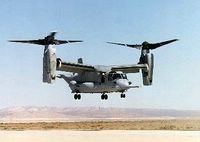Features: This versatile, self-deployable aircraft offers increased speed and range over other rotary-wing aircraft, enabling Air Force Special Operations Command aircrews to execute long-range special operations missions. The CV-22 can perform missions that normally would require both fixed-wing and rotary-wing aircraft. The CV-22 takes off vertically and, once airborne, the nacelles (engine and prop-rotor group) on each wing can rotate into a forward position
The CV-22 is equipped with integrated threat countermeasures, terrain-following radar, forward-looking infrared radar, and other advanced avionics systems that allow it to operate at low altitude in adverse weather conditions and medium- to high-threat environments.
Background: The CV-22 is an Air Force-modified version of the U.S. Marine Corps MV-22 Osprey. The first two Air Force test aircraft were delivered to Edwards Air Force Base, Calif., in September, 2000, for flight testing. The 58th Special Operations Wing at Kirtland AFB, N.M., began CV-22 aircrew training with the first two production aircraft in 2006.
The first operational CV-22 will be delivered to Air Force Special Operations Command's 1st Special Operations Wing at Hurlburt Field, Fla., in fiscal 2007. Initial operating capability is scheduled for fiscal 2009 with a total of 50 CV-22 aircraft delivered by fiscal 2017.
Download Full High Resolution Image
 | Air Force Special Operations Command's CV-22 Osprey flies a training at Kirtland Air Force Base, N.M. The aircraft will be flown by Airmen with the 58th Special Operations Wing. (U.S. Air Force photo) High Resolution Image |

1 comment:
you sujck
Post a Comment